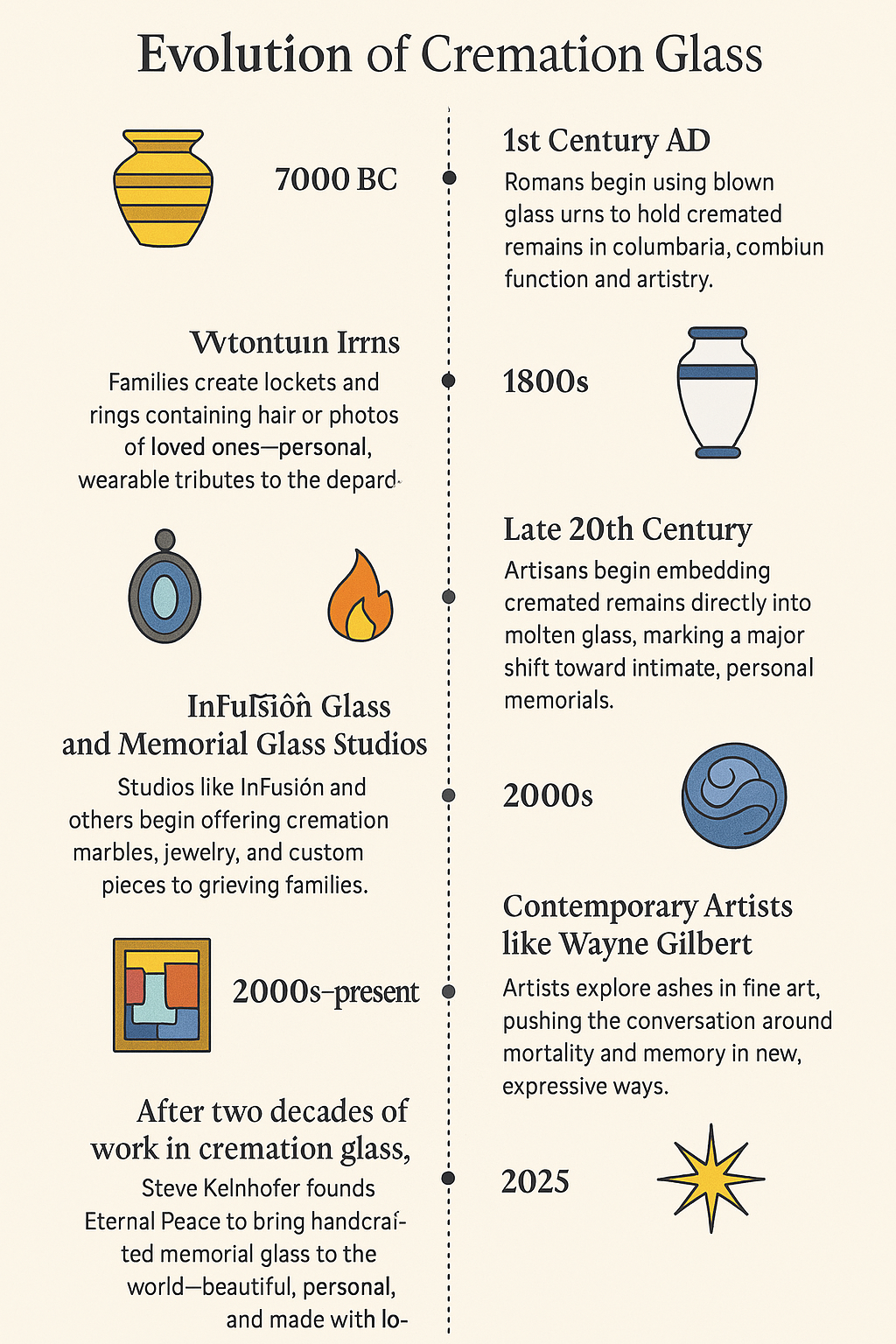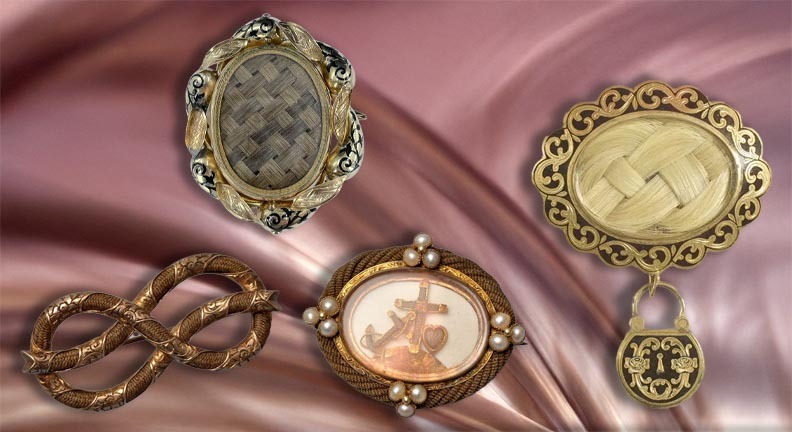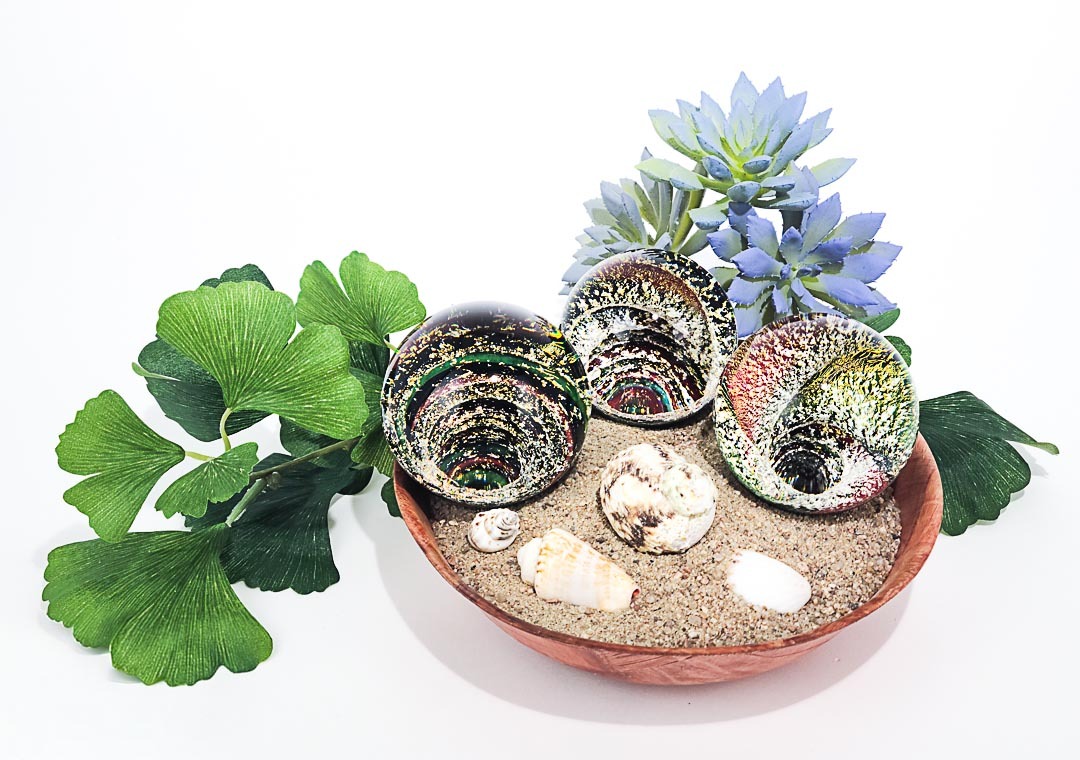The Evolution of Cremation Glass Art

Honoring Loved Ones Through the Ages
The practice of commemorating the departed has taken various forms throughout history, reflecting cultural values, artistic expression, and personal remembrance. Among these, cremation glass art stands out as a poignant fusion of fire, artistry, and memory. This journey through time explores how the integration of ashes into glass has evolved into a cherished method of memorialization.
Ancient Beginnings: Early Cremation Practices
Cremation is an ancient ritual, with evidence dating back to at least 17,000 years ago. The discovery of the Mungo Lady in Australia—a partially cremated body—attests to early human engagement with fire as a means of honoring the deceased. In regions like the Middle East and Europe, both burial and cremation practices coexisted during the Neolithic era, reflecting diverse cultural approaches to death and remembrance. Wikipedia
The Rise of Cremation Urns: Functional Artifacts
As cremation became more prevalent, especially among ancient civilizations such as the Greeks and Romans, the need for vessels to house cremated remains led to the creation of cremation urns. The oldest known cremation urns, dating back to around 7000 BC, were discovered in China, highlighting the longstanding tradition of preserving ashes in dedicated containers. American MemoryCraft
By the 1st century AD, the Romans began utilizing hand-blown glass urns, showcasing their advanced glassmaking techniques. These urns, found in the columbaria of Rome, not only served a functional purpose but also displayed artistic merit, with intricate designs that have withstood the test of time. American MemoryCraft
Victorian Mourning Jewelry: Personal Keepsakes
 The Victorian era (1837–1901) was a time of deep symbolism, strict social customs, and elaborate mourning practices. Among these customs emerged a profoundly personal and artistic tradition: mourning jewelry—a way for individuals to keep their departed loved ones physically close, quite literally woven into their lives.
The Victorian era (1837–1901) was a time of deep symbolism, strict social customs, and elaborate mourning practices. Among these customs emerged a profoundly personal and artistic tradition: mourning jewelry—a way for individuals to keep their departed loved ones physically close, quite literally woven into their lives.
As Queen Victoria mourned the loss of Prince Albert for decades, black attire and symbolic tokens of grief became part of everyday fashion, influencing people across Britain and beyond. But beyond the outward shows of mourning, families began seeking something more intimate—something that held a piece of their loved one in a form that could be seen, touched, and treasured.
One of the most distinctive expressions of this desire was the use of hair from the deceased, meticulously cleaned, shaped, and incorporated into rings, lockets, brooches, bracelets, and pendants. These weren’t macabre—they were works of love and craftsmanship. Hair was often braided, woven into floral designs, or even used to form miniature portraits or initials. Paired with gold, jet, enamel, and sometimes engraved with names or dates, these items became powerful keepsakes of memory and presence.
Far from being hidden away, these pieces were worn regularly—close to the heart, wrapped around a wrist, or set into a locket that opened to reveal both hair and portrait. Some lockets even included glass coverings to protect the delicate strands inside—a subtle precursor to today’s cremation glass art, where a part of the loved one is encased in clarity and beauty.
This practice reflected a universal truth that transcends time: in grief, we reach for connection. And often, we find healing through something tangible, something artful, something uniquely ours.
Modern Innovations: Ashes Infused in Glass Art
 Where Flame Meets Memory, and Grief Transforms into Beauty
Where Flame Meets Memory, and Grief Transforms into Beauty
The modern evolution of cremation memorials has ushered in a powerful shift—from traditional urns kept on shelves to intimate, wearable, and displayable glass art that keeps loved ones close in both form and spirit. The idea of infusing ashes directly into molten glass emerged in the late 20th century as artists and families sought more personal, expressive ways to honor the lives of those they had lost.
Unlike earlier forms of memorialization, such as urns or shadow boxes, cremation glass creates a physical fusion between the essence of a person (or pet) and the timeless beauty of glass. The process involves carefully embedding a small portion of ashes into molten borosilicate glass—a type of glass known for its durability, clarity, and resistance to thermal shock. The ashes remain suspended like wisps or clouds, preserved forever in a shimmering, crystal-clear medium.
From this process come stunning keepsakes:
-
Jewelry like pendants, rings, and earrings
-
Functional pieces such as wine glasses and paperweights
-
Sculptures and figurines that represent hobbies, symbols, or animals
-
Custom designs that reflect the spirit, personality, or legacy of the individual
Each piece is one of a kind, capturing the unpredictability of the ashes as they interact with molten glass—like a fingerprint in flame.
The Rise of InFusion and Artistic Exploration
Studios such as InFusion Glass and others across the U.S. and U.K. began offering cremation glass memorials in the early 2000s, bringing this sacred art to a wider audience. Their work inspired more artists and grieving families to view remembrance not as a passive act, but as a creative and healing collaboration.
This period also saw advances in glassblowing techniques, tools, and color blending that allowed for a wider range of styles and more intricate designs. Artists began offering custom color palettes and theme-based pieces—from ocean waves for a loved one who adored the sea, to galaxies for those whose spirits reached for the stars.
Contemporary Artists Pushing Boundaries
Artists like Wayne Gilbert, a Texas-based contemporary painter, took the concept even further. Instead of traditional pigments, he began incorporating unclaimed cremated remains into his paintings—creating works that sparked both admiration and controversy. His art challenges viewers to confront mortality and question how society values remembrance, especially of those who may otherwise be forgotten.
In Gilbert’s words, it’s about giving the ashes “a place to be seen.” This bold expression adds another layer to the cremation art movement: not just preserving memory, but confronting death with creativity, honesty, and compassion.
The Emotional Power of Ashes in Glass
 For those who’ve experienced the loss of a loved one—whether a parent, partner, child, or pet—ashes in glass offer something rare: comfort you can hold. The transparency of glass becomes a metaphor for love that never fades. The swirl of ash tells a silent story. The glow of colored light through the piece brings warmth into grief.
For those who’ve experienced the loss of a loved one—whether a parent, partner, child, or pet—ashes in glass offer something rare: comfort you can hold. The transparency of glass becomes a metaphor for love that never fades. The swirl of ash tells a silent story. The glow of colored light through the piece brings warmth into grief.
Unlike static memorials, cremation glass allows people to integrate remembrance into daily life. A pendant worn to a wedding. A glass marble held during meditation. A wine glass used during a birthday toast. These moments turn grief into ritual, remembrance, and reconnection.
Eternal Peace: Crafting Timeless Memorials
At Eternal Peace, we honor this rich history by creating bespoke cremation glass art that serves as a lasting tribute to your loved ones. Our skilled artisans blend time-honored techniques with modern innovation to produce pieces that resonate with personal significance and artistic beauty.
Whether it's a pendant that rests close to your heart or a sculpture that graces your home, each creation is infused with care, respect, and the unique spirit of the individual it commemorates.
Embracing the Legacy
The evolution of cremation glass art reflects humanity's enduring commitment to remembering and celebrating those we've lost. From ancient urns to modern glass-infused keepsakes, these memorials offer solace, connection, and a tangible link to cherished memories.
At Eternal Peace, we are privileged to continue this tradition, crafting pieces that not only honor the past but also provide comfort and beauty for generations to come.
